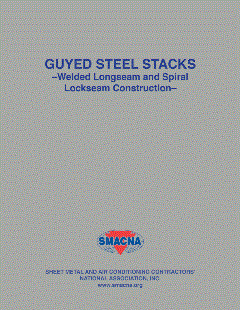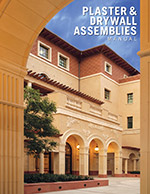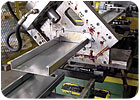
Readers of AID know that this reporter is a big fan of new technology. I am also becoming much more mindful of the planet I live on. My focus much of the time is now on how technologies-past, present and future-are affecting this wonderful blue ball. Lately, I can’t seem to get my fill of information on renewable energy, recycling and conservation. I think the most important technologies being researched today are the ones that address ways to become more friendly to our home.
No matter what side of the political aisle you stand on, you have to admit that trees are a necessary part of our eco-system. And as such, the world’s insatiable appetite for these carbon-dioxide-munching beauties is a very dangerous thing. In May 2000 some of the features and benefits of building with steel were discussed in an AID article co-written with my old pal Bill entitled “Life After Wood: Steel Studs on the Rise.” Like anything else, along with the benefits there are challenges.
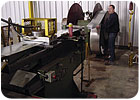
At one end of the 450-foot assembly line, a roll of steel is fed into a series of machines that will result in perfectly-sized steel studs.
FROM TANKS TO WALLS
Being able to rise to the challenge has always been a mark of success. In the early part of the 20th century this country was challenged by a world war. Many companies rose to that challenge and built armaments in a manner that had never been seen before. One of the reasons we still speak English and not German is because of companies such as the American Car and Foundry Co., deep within Pennsylvania Dutch country, in Berwick, Pa. The company employed thousands of residents during the war churning out the famous Stuart M3. It finally closed its doors in the early ‘60s.Exit one challenge, enter another; how to build environmentally-friendly steel structures in a factory. Within the cavernous space where tanks once rolled down the production line, now resides the manufacturing facility of Deluxe Building Systems Inc. I was lucky enough to be able to visit this plant recently during a shut-down for retooling and was able to talk in-depth with the production manager and had the freedom to walk the floor and take pictures.
To say I was impressed would be an understatement. From start to finish this is a turn-key operation. It starts with a full-on Engineering Department utilizing state-of-the-art 3D software that is able to design/build any structure up to 12 stories high. Next comes the factory.
Try to envision two quarter-mile-long assembly lines capable of running 1,000,000 square feet, per year, per shift:
• At the back of the plant is a roll former that has the capacity of running 10,000 linear feet of 24-14 gauge metal studs per shift.
• Next is a framing table that handles walls up to 16 feet in height and 65 feet long. As the wall rolls through the frame table it comes to the Triad screw bridge that houses 64 independent collated screw guns. Utilizing a staggered gun setup, screw spacing of 3 inches OC can be achieved in either drywall or plywood.
• The wall then rolls into the router station where windows/doors are cut out as dust is exhausted through a vacuum system.
• The walls are then lifted with a remote controlled hoist system and transported to the floor system already online.
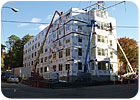
The final product is a completed room. All four walls, ceiling and floor have the final finish, including carpet, wiring and plumbing. They are put into place with a crane.
To meet fire code requirements, a 2-hour fire rating must be achieved for the floor systems. Up until recently that meant screwing down wire mesh and pouring concrete in-place. This whole procedure was very labor intensive. Thus, the next generation of fire-rated floors has embarked, Deluxe Style. By utilizing a special cement board instead of poured-in concrete, efficiencies are once again achieved.
The units-or boxes-are then transported to the site where they are lifted by crane into place. These boxes are aligned into preset pins and then welded together creating any configuration imaginable.
Due to being able to meet such great economies of scale in both purchasing and labor, Deluxe is able to compete in the new global market, and has shipped units as far away as Russia, Israel and the Caribbean.
What’s next? Who knows? Maybe someone at Deluxe will read one of my upcoming articles on solar energy and will find a way to integrate this technology into the next generation of “Building Deluxe Style”.
Remember: this blue ball is pretty cool, and your kids need it too.




